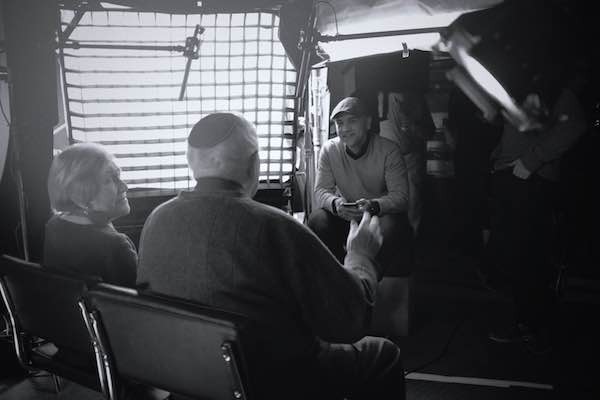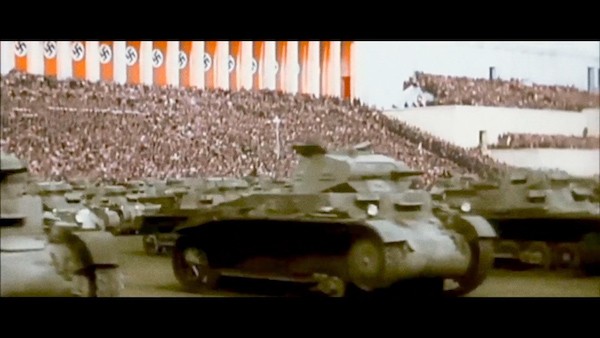Waheed AlQawasmi says his own experience as an immigrant colored his documentary Lives Restarted “I was born and raised in Jordan, and I emigrated here when I was 13,” says the director. “That was one of my main impetus for the story. You see a lot of holocaust documentaries, but they never really talk about what happened after, which was as much of a struggle as it was during the war. I had a couple of survivors tell me it was a bigger struggle for them, because they came here, they didn’t speak the language, they had no friends, and they literally didn’t know where their next meal was coming from.”

Director Waheed AlQawasmi conducts an interview with Memphis holocaust survivors for Lives Restarted.
AlQawasami’s company, WA Films, is a successful commercial video production house, and he used his considerable skills to tell this remarkable story of triumph over ultimate tragedy. “The way this project came together is, the Jewish Community Partners wanted to do a 3-4 minute video celebrating the accomplishments of the Holocaust survivors in Memphis to present it in their Yom Ha’Shoah program this year, which is a day of remembrance about the Holocaust. They approached a gentleman named Jerry Erlich, an advertising executive in town. I work with him a lot, we do commercials together. I said I would love to do it, and we just kind of went from there. We convinced them to turn this into a mini documentary to educate kids in schools about immigrants and their success stories, to show these people’s struggle.”
Lives Restarted skillfully combines archival footage of World War II and its immediate aftermath with contemporary interviews of Memphis holocaust survivors and their children. Much of the historical holocaust material came from Steven Spielberg’s Shoah Foundation. “I spent two weeks calling every day until I could get someone on the line. They were very kind and sent us that footage over to use. Between me, Brian and Ryan, we cleaned it up and tweaked the color. The reason I went out of my way to try to find those shots, is because of the educational nature of the venues in which this is going to be exhibited. Kids these days, if you put black and white in front of them, they’re not going to watch it. They’re just going to be bored. If it’s cut like a talking head documentary, they’re going to tune out. So we tried to cut it like a modern movie. We showed it at St. Mary’s, and none of the kids were on their phone the entire time.”

Although it is a historical documentary, AlQawasmi says he and his subjects found it remarkably—and depressingly—timely. “This was my way of dealing with the Syrian refugee crisis. I volunteered my time for this movie, although we had a budget. We put all the money on camera. I wanted to show people that this is a part of history that most of know about, and here’s what happened with the people after, and their struggle. Some of the survivors I talked to are really shocked at the way our politics are going right now. We just went through this, guys. And now you’ve got someone saying, ‘Kick everyone out!’ Most Americans associate Jews in America as being welcome in America, but history doesn’t remember it that way. What they’re saying about the Syrians now—that they’re spies and combatants who are trying to take over our country—are the same things they were saying about the Jews after the war. That’s why they didn’t come to America for up to ten years after the war, in some cases.”
The director says the film is also a way of giving back to people who came to his aid in his time of need, and he hopes his example will strike a blow against hatred. “I’m a Palestinian making a documentary about Jewish holocaust survivors. You have a lot of the Arab world who are not very knowledgeable about this material. They just see what they see on the news and say, ‘All Jews are bad.’ I never even met a Jewish person until I moved here at age 13. I had to meet someone to make an informed decision. It turned out to be one of the best communities I’ve ever witnessed in my life. They’ve been my friends, and I’ve worked with a lot of Jewish small businesses, and witnessed how to create a new life. When my dad left us, the only people who stood by me were my Jewish friends and employers. They helped me through my struggle.”
Indie Memphis Sunday: Documentary Lives Restarted Celebrates Memphis’ Holocaust Survivors
Lives Restarted screens as part of the Hometowner Cultural Documentaries bloc at Circuit Playhouse on Sunday, November 6 at 1:30 PM. You can purchased tickets and festival passes on the Indie Memphis website.